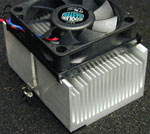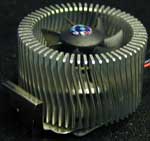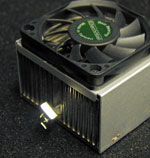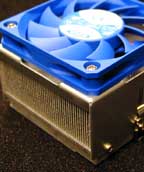last change: 08.08.2001
since 16.9.2000

Why the heck is there a tank ?!?
Main Page
"HowTo" Guides
Troubleshooting Guides
BIOS related information
CPU related information
Overclocking
Articles
Downloads
Forum
Links
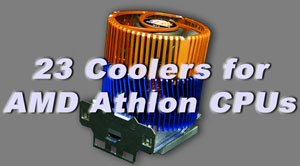 |
||||||||
|
With the Athlon CPUs getting ever faster and hotter a good cooling solution is more important today than ever. To give an overview about different designs this article will discuss 23 CPU coolers. A few of these coolers are not meant for the Athlon 1.33 Ghz CPU used. They were included nonetheless to give you a picture of what happens if you either choose a undersized cooling solution, or transcend its limits by overclocking. A Novelty in this test Cooler tests are something you can find at every corner of the internet. This is, as far as I know, the first test using the AMD Athlon Palomino's integrated temperature measurement diode for rating the performance of coolers. This has been done for Intel's Pentium CPUs since they included on-die temperature measuring. With AMD CPUs this was not possible up to now. But, with the availability of the first mainboards by Fujitsu-Siemens supporting this measurement and using a Palomino 1.33 Ghz CPU, we now have the best measurement method for the actual die temperature. Other measurements, be it measuring the heatsinks's temperature or measuring at the sides of the CPU die, have to be inaccurate due to the physical distance to the center of the die. Keep this, plus the ambient temperature of 35°C in mind when comparing absolute temperatures in this test with the ones of other cooler reviews. The temperatures there inevitably will be a significant amount lower, but the ones given by this test are closer to the reality inside a PC housing. Check out other cooler test nonetheless. Over at Tom's Hardware there is quite a good one, effectively comparing over 40 models. Some of the coolers tested there are reviewed here, too. Together with other tests around the internet this should give you a good idea of what designs are good - and which simply suck. Why these coolers and not others? Why is XYZ's Supercooler not included ? People asked that quite a few times. Well, because these were all the coolers available. As you might have noticed, there are NO advertisments on this site. This is purely a hobby and a "service" to the internet community, almost no money is to be invested. But if any distributors / retailers / manufacturers of all those fancy expensive high performance heatsinks would provide samples, these could be tested, too :-) Let's see, as interest in this test is quite good (20.000 hits today) perhaps there will be a follow up, soon ... CPU Cooler Design What AMD has to say on this issue can be found at their Tech document available from their tech site . Note that AMD specifies the maximum allowable weight at 300g. Some heatsinks exceed this ...
Questions ? Discuss this article in the Forum ! Next Topic : Test Setup |
Index
